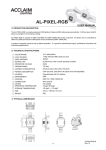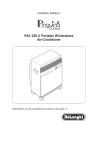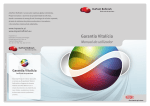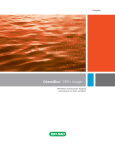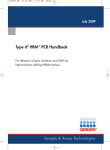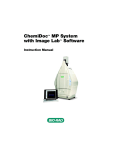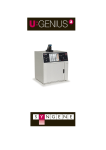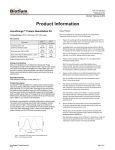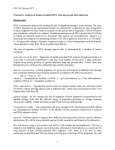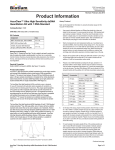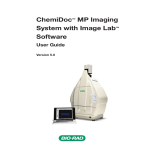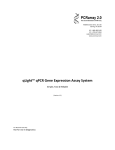Download PI-31005,31016
Transcript
3159 Corporate place Hayward, CA 94545 www.biotium.com Glowing Products for ScienceTM Last updated: November 10, 2010 Product Information Fast Probe Master Mix Catalog Number: 31005, 31005-1, 31005-2 or 31005-T Unit Size: 200 reactions (cat # 31005), 500 reactions (cat # 31005-1), 5,000 reactions (cat# 31005-2), or 100 reactions (cat # 31005-T, trial size) Components: The product is 2X probe master mix that contains dNTP, optimized buffer and stablizer (including Tris and MgCl2), and CheetahTM hot-start Taq polymerase. Cat # Unit Size 31005 200 rxn (2 X 1 mL) 31005-1 500 rxn (5 X 1 mL) 31005-2 5,000 rxn (50 X 1 mL) 31005-T 100 rxn (1 X 1 mL) Fast Probe Master Mix with ROX Catalog Number: 31016, 31016-1, 31016-2 or 31016-T Unit Size: 200 reactions (cat # 31016), 500 reactions (cat # 31016-1), 5,000 reactions (cat# 31016-2), or 100 reactions (cat # 31016-T, trial size) Components: The product is 2X probe master mix that contains dNTP, optimized buffer and stablizer (including Tris and MgCl2), CheetahTM hot-start Taq polymerase and ROX reference dye, which may be required on ABI and certain other instruments (See master mix selection guide for real time instruments below). This product is suitable for all color probes qPCR detection except for ROX channel probe . If you use ROX equivalent wavelength dye labeled probes (URA as in AllGlo probe), please choose Fast Probe Master Mix (Cat # 31005) instead. Cat # Unit Size 31016 200 rxn (2 X 1 mL) 31016-1 500 rxn (5 X 1 mL) 31016-2 5,000 rxn (50 X 1 mL) 31016-T 100 rxn (1 X 1 mL) Storage and Handling Fast Probe Master Mix is shipped on blue ice and should be stored immediately upon arrival at -20 oC. When stored in a constant temperature freezer at -20 oC, the kit is stable for at least 6 months from the date of receipt. Before use, thaw at room temperature and mix thouroghly by gentle vortexing. After thawing, the master mix should be kept on ice before use. It can be refrozen for storage. Product Description Fast Probe Master Mix is a ready-to-use hot-start mix for quantitative real time analysis of DNA samples from various sources using probe-based detection. Although optimized for AllGlo™ probe system, this master mix is also suitable for other probe systems such as hydrolysis probes such as TaqMan® and Molecular Beacon®. The AllGlo™ probe is a simple fluorogenic probe without quencher or MGB. AllGlo™ probes generate two light-emitting labels per probe, giving more intense fluorescence than traditional Taqman® probes. AllGlo™ probes is available in six colors, MAR, JUP, SAT, URA, NEP and PLU, which match with the absorption and emission wavelength of FAM, HEX, TAMRA, ROX, Cy5 and Quasar 670, respectively. These six AllGlo™ dye labels are compatible with most real time PCR instruments and generally require no special calibration. For detailed probe design guidelines refer to AllGlo™ user’s manual (www.allelogic.com). This specially formulated probe master mix offers strong signal and high sensitivity, which make gene quantitation and viral load assessment possible even for the most challenging samples such as tissue, blood or serum. The wide range of reporter dye choices enable multi-gene detection in a single tube and provide reliable results for multiplex applications such as SNP gene typing and pathogen detection. Although the master mix is formulated for qPCR using a fast cycling protocol, it is also compatible with qPCR using a regular cycling protocol (see below for recommended cycling protocols of Two-Step fast, Univeral and ThreeStep regular). ROX reference dye is not required for most of non-ABI instruments and not supplied in the mix (Cat # 31005). For well-to-well fluorescence normalization in ABI and some other instrument platforms, use the mix with ROX (Cat #31016), which ROX reference dye is conveniently included. Please refer to the master mix selection guide below to decide which master mix is best suited for real time instruments. Another critical component of the master mix is CheetahTM Taq, our proprietary chemically-modified hot-start DNA Polymerase. Unlike AmpliTaq Gold®, which is also a chemically modified Taq but takes 10 minutes or longer to activate, CheetahTM Taq is fully recovered in 2 minutes with high activity, making it particularly suitable for fast PCR. Cheetah Taq is completely inactive at room temperature and largely free of DNA contamination. This makes Cheetah Taq superior to any antibody-based hotstart Taq, which is typically not completely inactive at room temperature and is prone to DNA contamination due to the nature of antibody production. This kit is suitable for mRNA quantitation if a two-step procedure is followed. The first step involves converting the mRNA to cDNA by reverse transcription (components not provided). A portion of the synthesized cDNA can then be quantitated by using Fast Probe Master Mix in the second step. To ensure optimal amplification efficiency, the aliquot of the cDNA sample to be amplified should not exceed 10% of the volume of the PCR reaction. For accurate quantitation of mRNA level, a none-RT control is recommended to eliminate the possibility of genomic DNA contamination. 1 For one-step RT-qPCR, reverse transcriptase (components not provided) is required. It is critical to have well characterized primer set that does not form primer-dimer. We recommend to titrate the amount of reverse transcriptase and the duration of the RT step. If possible, design primers to have Tm at 55 oC, run both RT step and extension step at 55 oC. For accurate quantitation of mRNA level, a none-RT control is recommended to eliminate the possibility of genomic DNA contamination. Master Mix Selection Guide for Real Time Instruments Cat# Product PCR Instrument 31005 Fast Probe Master Mix BioRad: iCycler, MyiQ, MiQ 2, iQ 5, CFX-96, CFX-384, MJ Opticon, Option2, Chromo4, MiniOpticon Qiagen: Roto-Gene Q, Roto-Gene3000, RotoGene 6000 References 1. Xin X and Mao F. AllGlo™ Probe: Highly Specific Homo-Labeled Probe Technology for Real-Time qPCR. 3rd International qPCR Symposium. 26th - 30th March 2007, in Freising-Weihenstephan, ISBN-13: 978-3-00-020385-5 Eppendorf: Mastercycler realplex Illumina: Eco RealTime PCR System 2. Xin X. A closed-tube real time PCR system for simultaneous pathogen detection and mutation scanning. 2008. 11th WPCCID | PS3-078 Cepheid: SmartCyler Roche: LIghtCycler 480, LightCycloer 2.0 3. Mao F, Leung WY, Xin X. Characterization of EvaGreen and the implication of its physicochemical properties for qPCR applications. BMC Biotechnol. 2007 Nov 9;7:76. Additional Notes: 1) Data analysis: Absolute quantification is performed by plotting samples of unknown concentration to a standard curve from a dilution series of template DNA of known concentrations. A standard curve is first generated by plotting Ct (y-axis, threshold cycle) against the logarithm of DNA amount (x-axis, copy number). A linear regression is used to calculate the amount DNA of unknown samples. The slope of this line represents the efficiency of PCR reaction, which should be -3.3 if the efficiency is 100%. 2) ROX reference dye: Fast AllGlo Probe Master Mix with ROX (Cat #31016) contains optimal ROX reference passive dye, which is required on ABI and some other instruments. If you use ROX equivalent wavelength dye labeled probes (URA as in AllGlo probe), please choose Fast Probe Master Mix (Cat # 31005) instead. The concentration of ROX in a reaction will artificially affect the apparent read out of the fluorescence signals, but it will not affect the relative Ct as long as all reactions contain the same concentration of ROX. In general ABI 7900 needs more ROX reference dye than ABI 7500. Thermal Cyclers such as iCycler iQ5, iCycler IQ, MJ Opticon, MJ Chromo 4, Rotor-Gene 3000, RotorGene 6000, Rotor-Gene Q or LightCycler 480 do not need ROX reference dye for normalization. 3)Hydrolysis probes such as TaqMan probe cannot be used for melt curve analysis. To take advantage of both probe specificity and melt curve capability, we recommend a multiplex PCR reaction with AllGlo probes and EvaGreen dsDNA binding dye in one single tube (see reference 2.) 31016 Fast Probe Master Mix with ROX ABI: 7500, 7500 Fast, 5700, 7000, 7300, 7700, 7900, 7900HT, 7900HT Fast, StepOne, StepOne plus Stratagene: MX4000P, MX3000P, MX3005P AllGlo, MAR, JUP, SAT, URA, NEP, and PLU are trademarks of AlleLogic Biosciences Corporation.; AllGlo dyes and probes and their use are covered by US and international patents (U.S. Patent No. 7,667,024). ** TaqMan and Molecular Beacon is a registered trademark of Molecular Probes, Inc. *** Practicing real-time PCR may require a license from Roche or Applied Biosystems, Inc. * Related Products: EvaGreen dye, 20X in H2O, Cat # 31000 Cheetah Hotstart Taq DNA polymerase, Cat # 29050 Fast EvaGreen Master Mix, Cat # 31003 Fast EvaGreen Master Mix with Low ROX, Cat # 31014 Fast EvaGreen Master Mix with High ROX, Ca t# 31015 dNTP Set, 100mM, Cat #40052 dNTP Mix, 25mM, Cat # 40053 dNTP Mix, 10mM, Cat # 40054 PMA for selective detection of live pathogens by PCR, Cat # 40013 GelRed nucleic acid gel stain, 10,000X in H2O, Cat # 41003 GelGreen nucleic acid gel stain, 10,000X in H2O, Cat # 41005 2 PCR Protocols 1. Reaction Setup To prepare probe stock, refer to the probe amount listed on the Oligonucleotide Specification Sheet. For each 1 nmole of fluorescence labeled probe, add 100 μl dH2O to make 10 μM stock, which can be used as 20X if the final probe concentration is 500 nM. Pipet reaction components into each well according to the table below: Reaction component Amount required for 20-uL reaction Final concentration 2X Fast Probe Master Mix 10 uL 1X Primers x uL each 0.1-0.5 uM each Probe x uL each 0.1-0.5 uM each Template x uL See Helpful Tip # 1 ROX Optional See Helpful Tip # 2 H 2O Add to 20 uL Helpful Tips: 1) Amplicon length: To maximize amplification efficiency with Fast Probe Master Mix, the optimal amplicon length is 50-100 bp. If longer amplicon is intended, you may need to extend elongation time. For hydrolysis probes which require 5’ exonuclease activity, the close the probe to the primer, the high the signal the reaction generates. 2) ROX reference dye: ROX reference dye is not required for most of non-ABI instruments and not supplied in the mix (Cat # 31005). For well-to-well fluorescence normalization in ABI and some other instrument platforms, use the mix with ROX (Cat #31016), which ROX reference dye is conveniently included. Please refer to the master mix selection guide in page 2 to decide which master mix is best suited for real time instruments. 2. Cycling Protocol You may choose one of the following three protocols, depending on the nature of your amplicon and instrument capability. A. Two-step fast cycling protocol This cycling protocol should be applicable to hydrolysis probes when the amplification is short and the primer and probe Tm’s are close to 60 oC. Temperature Holding Time Number of Cyles Enzyme activation 96 oC 2 min 1 Denaturation 96 oC 5 s (See Helpful Tip #3) Annealing & Extension 60 oC 30 s Cycling Step 40 Helpful Tip: 3) Denaturation time: The holding time for denaturation can be lower than 5 seconds, including as low as 0 second, if you have a relatively short amplicon. When the denaturation time is set to 0 second in the program, it merely means that the temperature will ramp to 96 oC and then will immediately ramp down with no delay. Setting the time to 5 s will ensures a more robust denaturation for relatively long or high GC amplicons. Instruments with fast ramping capability further add reliability to amplicon denaturation. B. Universal cycling protocol This traditional cycling protocol can be used on nearly all qPCR instruments. The protocol may also benefit targets that are relatively difficult to amplify under fast cycling condition. Temperature Holding Time Number of Cyles Enzyme activation 95 oC 5 min 1 Denaturation 95 oC 15 s Annealing & Extension 50-60 oC (See Helpful Tip #4) 60 s Cycling Step Helpful Tip: 4) Annealing & Extension temperature: The Tm’s of primers and probe can be designed identical and as low as 50 oC. Accordingly, the annealing & extension temperature should be set to match the Tm of the primers. This will benefit AT-rich amplicons. 40 3 C. Three-step cycling protocol This cycling protocol can be used for probe systems like Molecular Beacons when Tm’s of the probe is equal to or lower than 60 oC. An extra extension step at 72 oC helps the polymerase to completely extend the product. Holding Time Number of Cyles 95 oC 5 min 1 Denaturation 95 oC 15 s Annealing 50-60 oC (See Helpful Tip #4) 30 s Extension 72 oC (See Helpful Tip #5) 30 s Cycling Step Temperature Enzyme activation Helpful Tips: 5) Extension temperature: Taq extends most efficiently at 72 oC. However, for AT-rich amplicons (>70% AT) or amplicons that have an AT-rich patch, extension at 72 oC should be avoided. 40 3. Data Acquisition Probe-based fluorescence data acquisition depends on the chemistry used. For AllGlo probe or TaqMan chemistry, please refer to the following table for the excitation and emission wavelengths for each dye label. AllGlo Probe Dye Spectral Properties AllGlo Dye Detection Channel Excitation Peak (nm) Emission Peak (nm) MAR FAM 495 520 JUP HEX/JOE/VIC 525 550 SAT TAMRA 555 580 URA ROX/TEXAS RED 575 600 NEP Cy 5 635 670 PLU Quasar 670/Alexa 680 685 720 4




